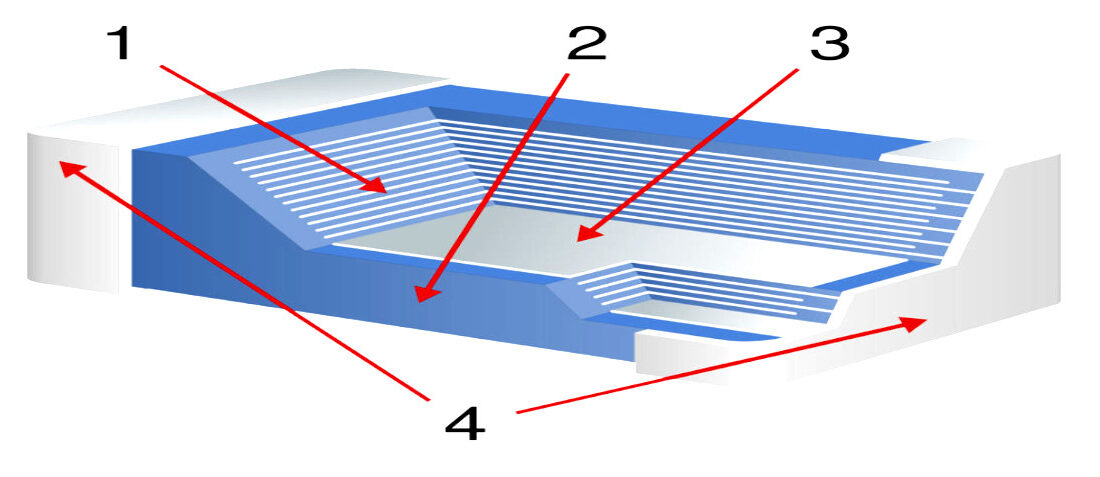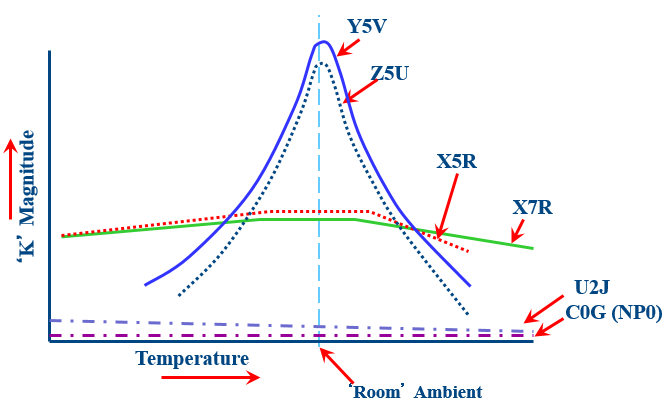
Class 2 ceramic dielectrics
- Posted by doEEEt Media Group
- On July 27, 2020
- 0
Class II dielectrics are made of ferroelectric materials. The most commonly used materials are alkaline earth titanates. Most of these dielectrics are based on barium titanate (BaTiO3). These dielectrics exhibit less stability but higher volumetric efficiency than Class I types, and are very commonly used in electronic circuits for coupling, decoupling, bypass, and frequency discrimination applications.
While they exhibit predictable changes in performance over a temperature, frequency, voltage and time range, Class II capacitors are not suitable for applications that demand superior stability of capacitance or high-quality factor (Q).
X7R is by far the most common Class II dielectric in use today, but X5R and high-temperature X8R/X8L types are also common. The letter-number-letter naming system used for Class II ( & Class III) dielectrics specifies the temperature characteristics of a dielectric material. The first letter specifies the lower temperature, the second digit specifies the upper temperature, and the third letter specifies the allowable change in capacitance as a percentage.
The table below provides details.
| wdt_ID | Low Temp. Limit | High Temp. Limit | Change Over Range |
|---|---|---|---|
| 1 | X -55°c | 4 +65°c | A ±1.0% |
| 4 | Y -30°c | 5 +85°C | B ±1.5% |
| 7 | z +10°C | 6 +105°C | C ±2.2 |
| 10 | 7 +125°C | D ±3.3% | |
| 13 | 8 +150°C | E ±4.7% | |
| 16 | 9 +200°C | F ±7.5% | |
| 19 | P ±10% | ||
| 22 | R ±15% | ||
| 25 | S ±22% | ||
| 28 | T +22%-33% |
Changes in frequency, temperature, time, or voltage have significant effects on the performance characteristics of Class II capacitors. Some of the characteristics that are significantly affected by these changes include capacitance, DF, and insulation resistance.

Figure 1 K constant (and thus capacitance) behavior with temperature by different dielectric types, source: Kemet
The total impedance, capacitance, and DF of Class II capacitors are greatly dependent on frequency. The total impedance of a capacitor depends on the following three components: capacitive reactance, equivalent series resistance (ESR), and inductive reactance. Changes in frequency have significant effects on these components. An increase in frequency causes a decrease in capacitive reactance and an increase in inductive reactance. The frequency at which the capacitive reactance balances with the inductive reactance is referred to as the self-resonant frequency. At this frequency, the impedance is purely resistive and is dependent on the ESR only.
The capacitance and DF of Class II capacitors are significantly affected by changes in temperature. The temperature characteristics of a dielectric material determine the maximum change in capacitance. These temperature characteristics vary from one dielectric formulation to another. The insulation resistance of a Class II capacitor is also affected by variations in temperature. An increase in temperature results in a decrease in insulation resistance.
Some performance characteristics of Class II dielectrics change with time. This gradual change in performance characteristics with time is commonly referred to as aging. The crystalline structure of dielectric material is gradually realigned, and this results in a gradual loss of capacitance. This reversible gradual loss in capacitance is logarithmic with time. The X7R dielectric exhibits 2.0% aging per decade of time.
The process through which a capacitor regains its lost capacitance is referred to as de-aging. This is achieved by heating a component to a temperature that is above its Curie point. The results mainly depend on the temperature that a component is heated to as well as the length of time. The initial capacitance of a component is regained if heating conditions are sufficient.
Some characteristics of Class II and III capacitors are significantly affected by variations in applied voltage. Such changes in applied AC or DC voltages affect capacitance and DF of these capacitors. If a DC voltage exceeding 5V is applied to a capacitor, it causes the capacitance and the DF of the component to reduce. The amount of capacitance loss when a DC voltage is applied depends on the dielectric formulation. Ceramic capacitors with thinner dielectric layers tend to lose more capacitance when the voltage is applied.
Applying an AC voltage
The effect of applying an AC voltage to a Class II capacitor depends on the amount of voltage applied. Application of a 10-20 VAC to these capacitor causes an increase in the capacitance and the dissipation factor of the component. Applying a higher AC voltage to a component causes its capacitance and DF to reduce.
Barium titanate, the alkaline titanate that is commonly used in most formulations for Class II dielectrics, has a crystal structure and exhibits piezoelectric characteristics. When subjected to external stress, the titanium molecule in the dielectric material starts to oscillate. The piezoelectric characteristic of barium titanate can cause Class II capacitors to exhibit piezoelectric or microphonic behavior.
Capacitor manufacturers use various design techniques to optimize the performance characteristics of Class II capacitors. Some of the design techniques that are commonly used to enhance the performance characteristics of these components include overlapping the electrodes, narrowing the spacing of the electrodes, and adding additives to formulations. Narrowing the spacing between electrodes and overlapping them is commonly used to improve frequency and voltage characteristics while additives are mostly used to optimize the TCC of a dielectric material. Transition element oxides and alkaline earth metals are commonly used as additives.
Applications of Class II dielectric materials
High-K Class II dielectrics yield high volumetric efficiency but lower relative stability than Class I types. Class II capacitors are suitable for a wide spectrum of applications including blocking, bypassing, and decoupling applications. These capacitors are mostly used in applications where Q and stability are not of paramount importance.
- Space-Grade components available for immediate delivery - April 10, 2025
- Exclusive stock on doEEEt: How to access and request - April 10, 2025
- Managing EEE components for LEO and lower cost space missions - December 17, 2024

0 comments on Class 2 ceramic dielectrics